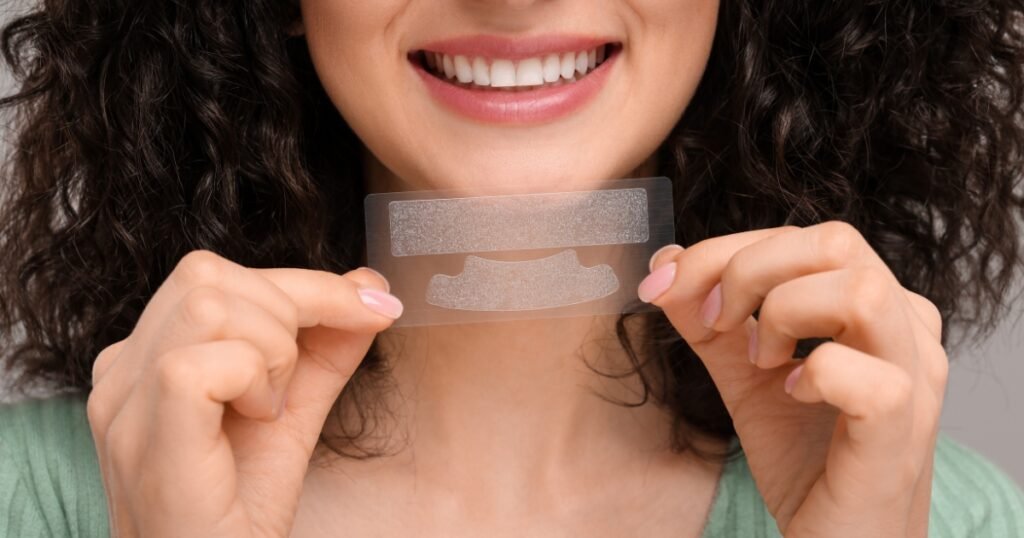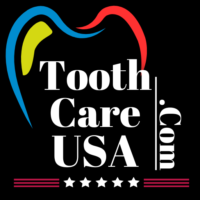Now, a few of the most common products used to whiten teeth at home are whitening strips. So they do work well, are easy to use, and are cheaper than most other whitening modalities. They also provide nice whitening in a relatively short amount of time. One question most often asked is: How often can you use whitening strips?
Whitening strips that are overused can lead to tooth sensitivity, gum irritation, and damage to the enamel. Using them too infrequently, however, won’t help you get the results you want. This post will cover how frequently you can safely and effectively use whitening strips, and some of the reasons for wanting to use whitening strips, considering the risks associated, then finally, I’ll cover how to properly maintain a more brilliant smile.
Understanding How Whitening Strips Work
The active ingredient in whitening strips is a peroxide-based bleaching agent, which most often is hydrogen peroxide or carbamide peroxide. Hydrogen peroxide contacts the tooth surface when applied over the teeth. It starts working on the yellow stains that are covering the enamel. The strips are thin, flexible plastic that are coated with a whitening gel that conforms to the surface of your teeth.
When applied, the bleaching agent penetrates the enamel and oxidizes the colored large molecules that are responsible for the color. It removes both extrinsic stains (stains on the enamel) and intrinsic stains (the ones formed with age and drug therapy).
How Often Can You Use Whitening Strips?
Frequency of Use : How often to use whitening strips; there are a variety of factors that come into play here, such as which brands you use, what the concentration of peroxides is in them, and how sensitive your teeth are. Here are broad rules of thumb depending on which type of whitening strip you choose:
1. Standard Whitening Strips (6%–10% Hydrogen Peroxide)
- Use once daily for 7−14 days
- Results last for six months
- If necessary, repeat every 3−6 months
2. Extra-Strength Whitening Strips (10%–14% Hydrogen Peroxide)
- Apply Once a Day for 7-10 Days
- In light of the greater probability of sensitivity
- Not to exceed twice per year
3. Mild or Sensitive Teeth Whitening Strips (Lower Peroxide Levels)
- Use daily or every other day
- Given for 10 days to 28 days
- Best for those with sensitive teeth
4. Express or Professional-Level Whitening Strips (Higher Peroxide Levels, 14%–20%)
- Apply once per day for a course of 3−7 days
- Not recommended for regular treatment
- More suited for expressing results before an event
5. Daily Whitening Strips (Low Peroxide or Non-Peroxide)
- Use daily for continued maintenance
- Considered safe for long-term use without harming enamel
Factors That Affect How Often You Should Use Whitening Strips

Several factors determine how often you can safely use whitening strips:
1. Tooth Sensitivity
In layman’s terms, you are said to have sensitive teeth if tooth whitening strips hurt when you use them. Therefore, tooth wax strips with a lower strength can be used with a day separation, not for daily use.
2. Enamel Strength
If your tooth enamel is weak or if you have dental work that includes cavities, gum recession, etc., consult the dentist first before using whitening strips. Beyond that point, the enamel can be thinned, and the teeth can become more sensitive.
3. Whitening Goals
For moderately stained teeth, the typical whitening journey should be around 2 weeks’ time. A stronger remedy should be sought if they are discolored, yet the product must not be overused. For upkeep of whiteness, use the mild whitening strip treatment once a week or every other week after the primary treatment.
4. Diet and Lifestyle
If you drink coffee, tea, or red wine, or you smoke, your teeth will discolour more rapidly and you will need whitening more frequently. Rinse your mouth or brush right after consuming something that could stain your teeth, and that will help the whitening last.
5. Brand and Formula
Various brands have different recommendations for how often to apply the treatment. Please make sure you follow the instructions on the package of the strips.
Dangers of Using Too Many Whitening Strips

This is the primary concern that you need to be aware of when overusing whitening strips:
1. Tooth Sensitivity
The extra peroxide exposure may cause a temporary sensitivity or a longer-lasting one that makes hot or cold food unpleasant.
2. Gum Irritation
The bleaching products contain chemicals that can irritate the gum tissue. There may be redness and swelling, slight burning sensations, and so on.
3. Enamel Damage
Enamel is compromised from its chronic whitening, meanwhile until the cavities and erosions and all the alcoholic whisk when sucked who went to drinking sweet hive for teeth type situation.
4. Uneven Whitening
Too much whitening also creates patchy or uneven whites, if you will, where some parts are whiter than others.
5. Translucency or Chalky Appearance
Using them regularly raises the potential for your teeth to appear unnaturally white and highly prone to having a bluish tint or chalky effect that indicates the enamel is being thinned.
The Safest Way to Whiten Your Teeth
Adopting the above best practices can aid in getting the best whitening result and ensure that your teeth are protected:
1. Follow the Manufacturer’s Instructions
Every brand has its own special rules on how to use its strips. Stick to what is advised.
2. Use a Desensitizing Toothpaste
Sensitivity can be controlled by using fluoride or potassium nitrate toothpaste, which will protect the enamel and reduce discomfort.
3. Take Breaks Between Treatments
If, after another cycle of whitening, three to six months pass, just another round of whitening can commence to allow recovery of the enamel.
4. Avoid Staining Foods and Drinks
Much consumption of barrel stains, much of which is familiar to us, is good. If you have, then rinse or brush your mouth.
5. Maintain Good Oral Hygiene
Twice-a-day brushing, with flossing and whitening mouthwash, will diminish the need for touch-ups of whitening treatments at home to keep the results.
6. Consider Professional Whitening if Needed
If you find yourself in need of whitening treatments quite frequently, discuss with your dentist long-lasting professional treatments with less risk.
Conclusion
The frequency of use varies with the type of strip, tooth sensitivity, and whitening goals, but in general, whitening strips can be used 7 days in a row or for 14 days once a day. They will stay safe to use indefinitely as long as you visit for touch-ups every 3-6 months. Use too much and it could cause some issues, etc, etc.
For a healthy smile, brush and floss regularly, and be on the lookout for over-whitening of the teeth. If you have any concerns, make sure to visit your dentist. With safe and effective use of whitening strips, you can have a sparkling white smile without sacrificing your dental health.
🦷 Tooth Whitening Risk Checker
Webstory On Whiting Strip
FAQs on How Often Can You Use Whitening Strips
How often can you safely use whitening strips?
Subject to the product being used, whitening strips may be used once a day for 7 to 14 days per treatment period. Other factors like peroxide concentration or a person’s tooth sensitivity must be considered when deciding on the treatment frequency; for this reason, most practices recommend that a 3–6 month gap be allowed between treatment sessions to avoid any risk of enamel damage.
How often can I use high-strength whitening strips (10%–20% peroxide)?
Super strength whitening strips should be applied once a day over 3-7 days, depending on the brand. They deliver more speedy results, but can increase sensitivity as well. Recommended use is only two times per year to protect the enamel.
Can I use whitening strips if I have sensitive teeth?
Yes, although you would want to select strips branded as “for sensitive teeth” since those contain less peroxide at lower levels and they’re also designed to be gentle. So you can alternate those with your other glasses to take the edge off the pain. This serves to prevent any further pain. The use of desensitizing toothpaste (e.g., Sensodyne) can also be helpful.
Can I reuse whitening strips to extend their use?
No, whitening strips are disposable. It would be a waste of time not to. The whitening effect is largely depleted once you use it for the first time. An occasional touch-up once every 3-6 months is recommended to keep teeth whiter.
Will using whitening strips more often make my teeth whiter?
Not necessarily. Extra does not mean more effective whitening, and overdoing it can lead to side effects, including sensitivity and enamel damage. For best results, continue to use the full recommended treatment. Upkeep regular oral hygiene to keep your whiter, brighter smile.
How can I maintain my whitening results without using strips too often?
Whitening strips don’t work on crowns, veneers, fillings, or dental implants. They whiten only natural teeth. If you’ve got a combination of both natural and artificial teeth, bleaching can result in some color irregularities. Ask your dentist about other teeth whitening options.
Can I use whitening strips if I have dental work (crowns, veneers, or fillings)?
Whitening strips don’t effectively whiten crowns, veneers, fillings, or implants. They can’t whiten fillings, dentures, veneers, or crowns. If you have natural and artificial teeth mixed, bleaching can cause the natural teeth to become two-toned looking. There are a variety of other methods that you can discuss with your dentist.
Final Thoughts
Whitening strips are an excellent, quick method of achieving a beautiful smile, but overuse can cause your teeth to be damaged and your enamel to be stripped. Safest is once daily for 7-14 days/cycle, 3-6 months apart. The brushing may be too abrasive. If this happens, sensitivity of the teeth will occur, or it will lead to overuse and damage to the enamel . It is always best to go visit a dentist to get the best advice.

Dr. Niraj Ghanghoriya is a passionate dental surgeon with over 12 years of experience in clinical dentistry. He completed his BDS from the prestigious Sri Aurobindo Institute of Dentistry in 2012 and specializes in painless root canals, smile makeovers, and preventive oral care. Known for his patient-first approach and clear communication, Dr. Ghanghoriya aims to make dental knowledge accessible to everyone. When he’s not in the clinic, he enjoys writing informative dental blogs to help people take better care of their oral health.




